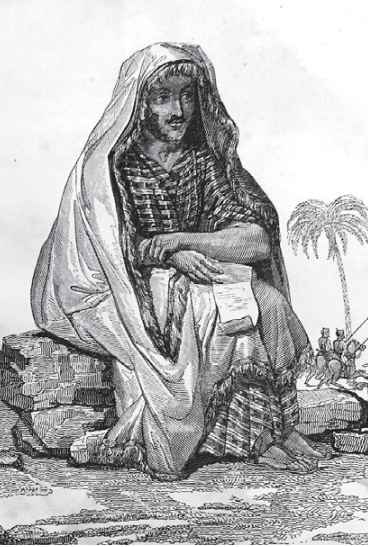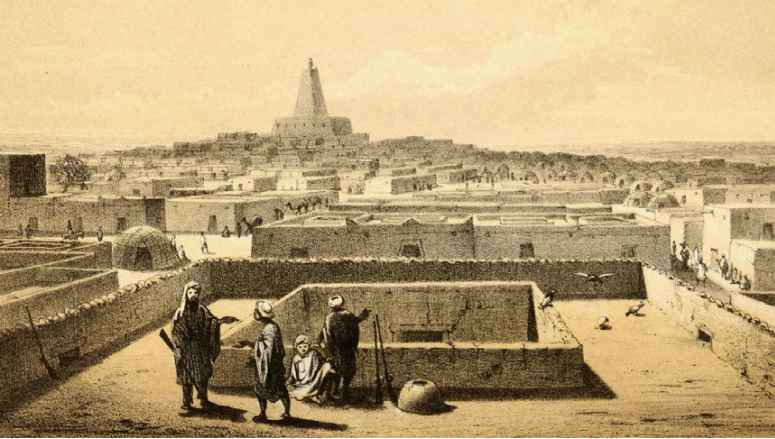When it comes to the desert, most people who have not experienced it in person can only imagine the magnificence of the "yellow ocean" or the sadness of "the sound of camel bells ringing in the ears". Those who have really experienced it and gone deep into the desert will recall the loneliness and powerlessness of being in the endless desert with no end in sight, as well as the endless yellow sand.
As a travel note said, "Sand is everywhere... Your breakfast, lunch, and dinner have added an unwelcome ingredient: sand. Some sand will accumulate in the remote corners of the human body: nostrils, navel, ear canal. All travelers who have walked through the desert will find tiny grains of sand several months after leaving the desert."
A simple fact is that all known organisms on the earth are basically carbon-based organisms, which naturally includes humans, that is, everyone’s life is based on carbon and water. Sand is mainly silicon-based, and it is impossible to provide any support for the existence of our human life. Therefore, for us humans and most creatures, the desert naturally becomes a forbidden zone for life.
It is precisely because of this that the Sassanid Empire and the Byzantine Empire once regarded the desert as a natural barrier and believed that they could not use troops, so they relied on it as a natural line of defense. However, in the 7th century AD, the Arab Empire relied on a large number of dromedaries provided by the Bedouins to cross the desert in one fell swoop, thus defeating the armies of the Sassanid Empire and the Byzantine Empire respectively and eventually rising.
It can be said that whether from a historical or military perspective, those who can cross or conquer the desert are undeniably strong! At the same time, the desert seems to have a kind of magic, attracting countless brave people to go deep into it without hesitation and explore. As traveler Wilfred Thesiger wrote in his article "Arabian Sands", "No one can live this life and still be the same. No matter how hard he tries to hide it, he will bear the mark of the desert! That is the mark of every nomadic people; and he will have a desire to return to the desert in his heart. Whether that desire is weak or strong depends on his personality. Because this cruel land has a kind of magic that no pleasant climate can match. And the highest honor of human desert exploration is to cross the world’s largest desert - the Sahara Desert!

The first attempt to cross the Sahara
It is well known that the Sahara Desert covers an area of about 9.06 million square kilometers and is the largest sandy desert in the world. It is located in northern Africa and was formed about 2.5 million years ago.
According to archaeological research, the first attempt of humans to cross the Sahara Desert was as early as BC. It started in the 11th century. Because archaeologists have discovered some Spanish-Moroccan style bronze artifacts in southern Mauritania, dating back to the 11th century BC. This shows that in prehistoric times, North Africa and sub-Saharan Africa had already had a certain degree of intermittent contact. Because the 50 mm rainfall areas in the west, north and south of the Sahara Desert are closely connected, forming a natural corridor that can cross the desert. This made it possible for prehistoric inhabitants of Morocco and Mauritania to interact with each other. By the 3rd century AD, North Africa had successfully domesticated dromedaries and used them to carry goods, making it possible for humans to directly challenge the Sahara.
But it was not until the 5th century AD that the nomadic Berbers in North Africa were able to cross the Sahara Desert by relying on camels as the technology of taming camels was further improved. Driven by the driving force of trade, by the 7th century AD, a stable trade route between North Africa and sub-Saharan Africa was finally formed. The Berbers in North Africa transported salt from North Africa to sub-Saharan Africa in exchange for gold and slaves produced locally. Since ancient Arabs and Europeans used gold to make currency, there was a great demand for gold in West Africa. According to historical statistics, 2/3 of all the gold circulating in the Mediterranean region in the Middle Ages was imported through the Sahara Desert. The slave trade was also huge. Every year, sub-Saharan Africa imported about 6,000-7,000 slaves to North Africa, most of whom were used as servants, concubines, and slave soldiers. From the 8th to the 9th century AD, Arab merchants entered the southern part of today’s Morocco and bought gold from the Berbers. Islam was thus spread to the Berbers through Arab merchants, and finally to sub-Saharan Africa along the trade routes.
Of course, around these busy trade routes are the bones of countless pioneer explorers and the unfortunate ones who followed. These victims have one thing in common, that is, they failed to leave their names.
There must be a brave man under a big reward
It was not until the 19th century that an explorer who became famous for crossing the Sahara Desert appeared. He was the French explorer René Auguste Caillié. In 1828, he crossed the Sahara Desert from the south and arrived in the north to visit Timbuktu on the southern edge of the northern Sahara Desert and survived, thus becoming the first European to cross the Sahara Desert in the era without modern transportation.
Rene Caillié was born in 1799 in a village near the port of Rochefort in western France. He was born in poverty, and his parents died early when he was young. Since René Caille was very interested in exploration and the story of Robinson Crusoe since he was a child, he took the 60 francs inherited from his grandmother and boarded a French warship at the age of 16 to leave his hometown and arrived at Port Saint-Louis, Senegal, West Africa, which was controlled by France, as a crew member. After spending some time in Port Saint-Louis, René Caille learned that the British expedition led by Major William Grey was preparing to set out from Gambia to explore the interior of Africa. René Caille expressed his hope to help Major William Grey, and was allowed to set out along the African coastline with his two companions. With this, Caille embarked on the path of an explorer.

However, Caille’s first expedition did not go well. He originally planned to travel 300 kilometers, but due to the scorching heat and severe water shortage in Africa, he had to give up his plan in Dakar and then went to French Guadeloupe. After working here for six months, René Kayet read the account of Mongo Parker’s expedition in the Niger River region. Encouraged by his deeds, René Kayet first returned to Bordeaux, France, and then set out again for Senegal.
In 1818, René Kayet arrived in Senegal and went directly to the interior to provide supplies for a British expedition. But he was once again plagued by bad luck. Soon he had to withdraw due to a high fever and returned to France to recuperate. In 1824, René Kayet went to Senegal for the third time. It can be said that René Kayet had a great interest in exploring the interior of Africa, and he fought again and again despite repeated failures. It happened that at this time, the Paris-based Geographical Society (Société deGéographie) offered a reward of 10,000 francs to the first European who went to Timbuktu and returned alive. In this regard, René Kayet was determined to give it a try!
However, René Kayet, who was eager to try, understood that only Arabs could complete the journey to Timbuktu. Therefore, he went to the desert area north of the Senegal River today, which now belongs to Mauritania, and learned Arabic and various laws and customs of Islam from the local Tuareg for a full 8 months.
It is important to note here that René Kaye’s preparations were not only to learn how to deal with the high temperature and lack of water in the desert, avoid sandstorms, learn to identify directions in the desert, and avoid poisonous snakes and scorpions in the desert. He had to learn more about how to deal with the hostility around him.
In the 19th century, Christian explorers were not welcome in this area due to the European colonization activities at that time. At the same time, the fierce Berber bandits in the desert were also quite dangerous. They wandered in the desert, ready to intercept and kill passing caravans at any time.
That is why René Kaye spent a lot of time learning Muslim traditions and languages before the expedition. Because as a Muslim, crossing the desert in a Berber caravan would be much safer than crossing it alone. But this does not mean that there is no danger. The local Berber caravans have a very strong Greek sexual concept, and René Kaye does not accept this sexual concept. Therefore, during the journey, he had to disguise himself as one of them, but also avoid being dragged into the hormone gathering by them.
After the preparations were completed, he showed the Governor of Senegal his plan to explore Timbuktu, but did not receive any funding from France. Faced with this blow, he resolutely decided to explore Timbuktu alone!
So why did the Europeans at that time have such a strong interest in Timbuktu? In fact, the Europeans at that time were not concerned about Timbuktu, but the legendary trade route across the Sahara Desert represented by Timbuktu, and the legendary "Golden Country"!
"Golden Country
Since the 16th century, the Portuguese have taken the lead in establishing colonial outposts in sub-Saharan Africa. Before 1598, the Portuguese monopolized the West African trade and obtained gold worth about 100,000 pounds in this region each year, accounting for 1/3 of the world’s total gold supply at that time 10. However, Portugal was unable to expand its colonial outposts and go deep into the interior, so it only carried out activities and trade in coastal areas. In the first half of the 17th century, due to the Portuguese-Spanish merger, Portugal’s colonial outposts in West Africa were basically taken away by Dutch colonists. In the second half of the 17th century, the Dutch colonial outposts in West Africa were impacted by Britain and France. In the 18th century, the Dutch advantage on the Gold Coast was completely replaced by the British, and the French seized the Dutch fortresses from Cape Brown to the Senegal River. In the early 19th century, due to the prohibition of slave trade, the Dutch trade outposts on the Gold Coast became useless, so they were transferred to the British in exchange for rights and interests on the island of Sumatra.
In fact, from the 17th to the 18th century, France has been based in Port Saint-Louis, constantly sending explorers, missionaries and merchants to the interior of Senegal, but all returned in vain. At the end of the 18th century, Europe set off a wave of exploration of the interior of Africa. Since the British had the greatest trade interests in Africa at that time and were most eager to open up markets, the British were particularly enthusiastic about exploring the interior of Africa, and the exploration of the interior of Africa at that time was also mainly carried out by the British. Especially after the slave trade was completely banned, European countries with relevant interests in Africa at that time were eager to find new trading partners that could replace the slave trade. Influenced by medieval Arab historians, in the minds of Europeans, the interior of West Africa is a good market with a large population and rich products, with Timbuktu as the core, and a large amount of gold from the "Land of Gold"!

So what is Timbuktu like? In the Middle Ages, the place was a regional trade center. Caravans that traded across the Sahara Desert would eventually gather here in exchange for gold, ivory, slaves and salt.
During the reign of the Mali Empire, Timbuktu became an important cultural and economic center in sub-Saharan Africa. The Songhai Empire caused some damage to Timbuktu during its conquest. However, with the Songhai Empire’s support for Timbuktu culture, Timbuktu had 150 schools, and was the cultural center of the Islamic world at the same time as Cairo and Baghdad at the time. A large number of judges, doctors, and preachers could receive remuneration from the monarch. And in Timbuktu, books are one of the most valuable commodities. Not only are there many public libraries in the city, but there are also a large number of private collections. Timbuktu’s population increased from 10,000 in the 13th century to 50,000 in the 16th century, and it attracted scholars from the entire Muslim world. However, in the 16th century, Timbuktu’s commercial status declined due to the establishment of the Atlantic trade route by the Portuguese. In 1590, the Moroccans invaded the Songhai Empire and wreaked havoc in Timbuktu. They plundered wealth, destroyed books, demolished buildings, and expelled merchants. Timbuktu thus completely declined.
Of course, these specific circumstances were unknown to Europeans. And René Kayet embarked on an adventure to pursue the legend of the "Golden Kingdom" in the sea of sand!
Explorers disguised as Egyptians
On April 19, 1827, René Kayet disguised himself as an Arab merchant, set out from the port of Conakry in Guinea, and crossed the Niger River in Kouroussa. However, when he arrived at Djenné, a trading town on the inland delta of the Niger River, he contracted scurvy and had to rest in Djenné for a full four months. After recovering, René Kayet continued northward and finally arrived in Timbuktu on April 20, 1828.
In this place, René Kayet disguised himself as a poor Egyptian who had lived in France for many years and returned to Africa. He then lived in Timbuktu for two weeks as such, constantly taking notes and drawing pictures. As mentioned earlier, what René Kayet saw and heard in Timbuktu was subversive to the Europeans’ previous understanding of this region. Timbuktu at this time had declined into a small settlement, which was very different from the Timbuktu recorded by Arab historians in the Middle Ages.
In addition, René Kayet also received such news: Alexander Lane, a Scotsman who was previously assigned by the British government to explore Timbuktu, had indeed successfully arrived in Timbuktu, so the latter was the first Western European to arrive in the city. However, Alexander Lane was murdered by his Muslim guide on his way back and failed to complete the expedition.
In early May, René Kayet followed a slave caravan crossing the Sahara Desert to the desert oasis of Tafilalt in Morocco. René Kayet was penniless after arriving in Rabat, the capital of Morocco, but still did not receive any assistance. However, this cold reception was also related to his preparations for crossing the Sahara. He used a false identity in Timbuktu. He claimed to the locals that he was an Egyptian Muslim who had lived in France for a long time (Napoleon brought back a group of Mamluk cavalry during his expedition to Egypt and formed a Guards Cavalry Corps with them). This identity played a big role in his safe crossing of the Sahara Desert by sneaking into the caravan. However, after arriving in Morocco, because of his identity and the fact that he imitated a Muslim too much from his dress to his behavior, he was rejected by many consulates in Morocco when he asked for help.

After that, he finally met with the French consuls in secret and obtained permission to return to France through them when he arrived in Tangier, a northern Moroccan port, on September 7. After René Caille returned to France, he won the Geographical Society Prize and a government pension for his feat of crossing the Sahara Desert and reaching Timbuktu alive for the first time.
In 1838, René Caille died of tuberculosis contracted during his expedition in Africa.
Although René Caille failed to find the legendary "Golden Kingdom" for Europeans, he found the "Golden Kingdom" in the field of human desert exploration with his perseverance and luck! He showed Europeans the actual situation of Timbuktu in the early 19th century for the first time, and explored the way to reach Timbuktu from the West African coast. Most importantly, René Callén showed Western Europe for the first time the trans-Sahara trade route from West Africa across the Sahara Desert to North Africa. Before René Callén, no explorer from Western Europe had ever tried to cross the desert from West Africa to Morocco or from Morocco to West Africa! It was not until 1849, 11 years after his death, that the British, based on René Callén’s successful experience, once again sent an expedition to try to cross the Sahara Desert from North Africa to West Africa. In March 1850, an expedition team consisting of the British Richardson and the Germans Bart and Ofer set out from Tripoli, crossed the Sahara Desert, and headed for an expedition to the interior of Africa.
On the way, Richardson and Ofoge died one after another, so Bart was the only one left. Bart alone explored Kano, Bornu, the middle section of the Niger River and its tributary Benue River, Lake Chad, Timbuktu, Gogo, the former capital of the Songhai Empire, Sokoto and other vast areas of Central and Western Sudan, which took 5 years and traveled 10,000 miles. Bart’s expedition collected a lot of first-hand information and made a great contribution to people’s understanding of West Africa at that time. Therefore, from the beginning of the Kayé expedition to the end of Bart’s expedition, it marked the final completion of Europe’s exploration of the interior of West Africa!




















